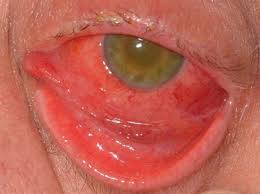 Presentation of bacterial disease is manifested by eye pan, redness, eyelid swelling and decreased vision.
Presentation of bacterial disease is manifested by eye pan, redness, eyelid swelling and decreased vision.
Results from endogenous or exogenous entry of pathogens into the eye.
Exogenous cases are the most common type and results from direct inoculation of pathogens.
About 60% of cases follow intraocular surgery.
Endogenous disease results from intraocular infection from hematogenous spread of bacteria.
Endogenous disease accounts for 2-8% of all cases.
25% of cases of endogenous disease are bilateral and unilateral disease involves the right eye twice as often as the left eye because of proximity to the right brachiocephalic arterial trunk.
Prognosis for endogenous form is much worse than for exogenous endophthalmitis due to more virulent organisms, impaired host conditions and delay in diagnosis.
Treatment for endogenous endophthalmitis associated with only 40% of patients with retention of vision.
Approximately 18% of cases of endogenous endophthalmitis associated with cardiac valves.
Associated with diabetes, cancer, drug abuse and invasive procedures.
